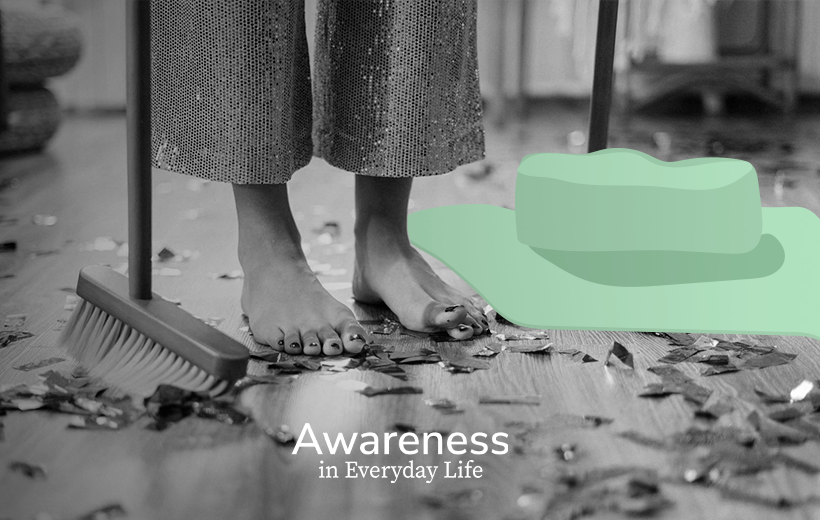Finding Work-Life Balance
By Masha Primachenko • 4 min read

IN MY PROFESSIONAL LIFE, I had been trained to work very long hours. I worked for an advertising agency, so we were constantly busy pitching projects, filming, and producing creative campaigns. I got used to a very intense pace! I am the kind of person who enjoys working, being part of projects, and contributing in meaningful ways.
However, when I think back, I see that at different times in my life, I was probably too obsessive. Inspiring ideas would take over my life and consume all my energy. Afterward, I felt hollow. This feeling was a clue that I needed to examine how I approached my work — the sheer volume of what I was doing and how I engaged with it. Over time, it became clear to me that I didn’t want to dedicate all my time and energy to one project or make a great career my singular goal in life. I needed to find balance: time for my family, for raising my daughter, and for pursuing my spiritual path.
I was tested when I joined Tergar International in 2020. This transition came with a double challenge: I was introduced to an entirely new work environment while navigating the uncertainties of the unfolding COVID situation around the world. At Tergar, we all worked hard to adjust to this new reality, shifting our activities online, streaming on YouTube, and hosting online retreats. It was a crazy, intense time but also a time of professional growth.
As a small non-profit organization, Tergar didn’t have extra hands, so we had to learn a lot very quickly and do much of the work ourselves. However, this was balanced by the incredible motivation and commitment of the team. Everyone really wanted to reach out and help people get through the challenging times.
Now, looking back, I see that challenging times are always with us. After COVID, other crises came, like war and political instability. There is always something demanding attention, and that very idea can feel exhausting.
One of the most important lessons I learned during this time was not to feel bad on the days when I needed to lie down and take care of myself. We don’t need to be heroic all the time, always saving something or doing good in the world, but we do need to be taking care of ourselves. This is the balance — and it’s especially important in mission-driven organizations like Tergar, where the work is deeply meaningful. Self-care is not selfish.
When I focus too much on outer things, I find answers by checking in with myself. How do I feel? Do I have energy? Do I feel full or depleted?
When I feel energized by what I’m doing — whether it’s something for myself or others — that tells me that I am approaching the task in a balanced way. Awareness practice has been a great tool for noticing the present moment. It helps me check in with myself, not in a self-obsessive “what-about-me” way, but in simply realizing what is happening.
For example, I might ask: How is my body feeling? Am I tired? If I notice that I am, I’ve found that power napping or simply resting between Zoom meetings can make a huge difference. Taking this time allows me to be far more efficient and focused when I return to my work.
Some days, when we feel like we’re really at the end of our rope, it’s because earlier in the day, the body and our mind were sending us signals to pause — and we just ignored them. In the past, I used to think: “I’ll wait until the weekend, and then I’ll really rest!” But it never happened this way. Instead, I found it more helpful to check in throughout the day with myself and recharge.
As a manager, I often hear many wonderful ideas for potential projects. I, too, tend to generate ideas and want to move things forward quickly. There are always tons of things that can be done to help this world, but that can be overwhelming.
Not every idea needs to be acted on right away. Over the years, I’ve learned to be more selective. It’s important not to push too hard. Maybe it can wait. Maybe it’s not time for this idea, no matter how wonderful it is. Letting go of an idea or project is not a sign of failure — sometimes, it’s a sign of wisdom.
I’ve seen over the years that important ideas tend to return. When an idea is meant to manifest, it will come back — and maybe when it does, we will be ready to execute it at an entirely new level.
In his monthly teaching, Mingyur Rinpoche talks about finding a balance between the personal, spiritual, and professional dimensions of our lives. For me, this means attending to whatever I’m doing at any given moment and letting go of all other things.
When I’m with my family, I’m with my family. I try to be fully present with them. When I’m on a Zoom call, that’s where my focus is. This approach helps to keep the balance. Bringing work situations into the family life, and then family life into the workspace, that’s where things can get messy!
I’ve also found it helpful to avoid overthinking situations that haven’t happened yet or ruminating on past events. I’m more likely these days to deal with problems as they arise, not to spend too much time anticipating them or dwelling on them afterward. I think that also helps me not to feel bad, not to feel guilty, and to avoid so many emotions that are very energy-draining.
This approach also helps with making decisions. Whether it’s something small, like choosing between different types of strawberries at the grocery store, or something more complex — it’s a complicated task for our mind to choose! With strictly the thinking mind leading, making decisions is hard because we get entangled in the pros and cons.
It helps to understand that there is no perfect decision to make. Maybe the decision is right, but it’s okay if it’s not. It’s okay to make mistakes sometimes. Allowing myself the freedom to make mistakes is a big part of the decision-making process, and keeping this in mind helps alleviate the pressure of decision-making.
The more we train to make different decisions on different levels in our lives, the more we can begin to trust the intuitive mind. Here, I am referring to the knowing part of the mind and the wisdom that arises in the moment.
I generally find that with Mingyur Rinpoche’s teachings, I have greater trust in change. So, whatever changes happen, I see it as part of the training. There is less fear that the change can harm “me” or that it’s “not good for me.” It’s all meant for us to grow, to open to more of our potential. This also helps in making decisions — accepting the changes that come invariably.
December 2024

Masha Primachenko turned to meditation to manage her anxiety and panic attacks. In 2012, she stumbled upon a YouTube video by Mingyur Rinpoche discussing panic attacks, and it really resonated with her. After meeting Mingyur Rinpoche in Bodhgaya in 2014, following his wandering retreat, she chose him as her main teacher. Masha is now a senior facilitator and one of the leaders of the Tergar Russia community. Professionally, she works in advertising and communication, currently serving as the Marketing and Communication Director for Tergar International. In her free time, Masha enjoys being outdoors with her family and traveling across India and Asia.
Learn meditation under the skillful guidance of world-renowned teacher Yongey Mingyur Rinpoche at your own pace.


“The approach and flying into Kathmandu along the edge of the Himalayas is spectacular,” Hughes said. This, along with Boudhanath, a Tibetan enclave in Kathmandu, are among his highlights.

Deadlines, competition, pressure — the concept of “burnout” to describe a sense of nervous exhaustion has been around since the 70’s, but never has the feeling of burnout been as prevalent as it is these days. In a situation that’s demanding too much of us, it’s natural to experience burnout. Still, there are certainly a…

“If you’ve ever cleaned your entire house instead of meditating, this story will feel all too familiar!”
If you enjoyed reading our articles, please join our mailing list and we’ll send you our news and latest pieces.